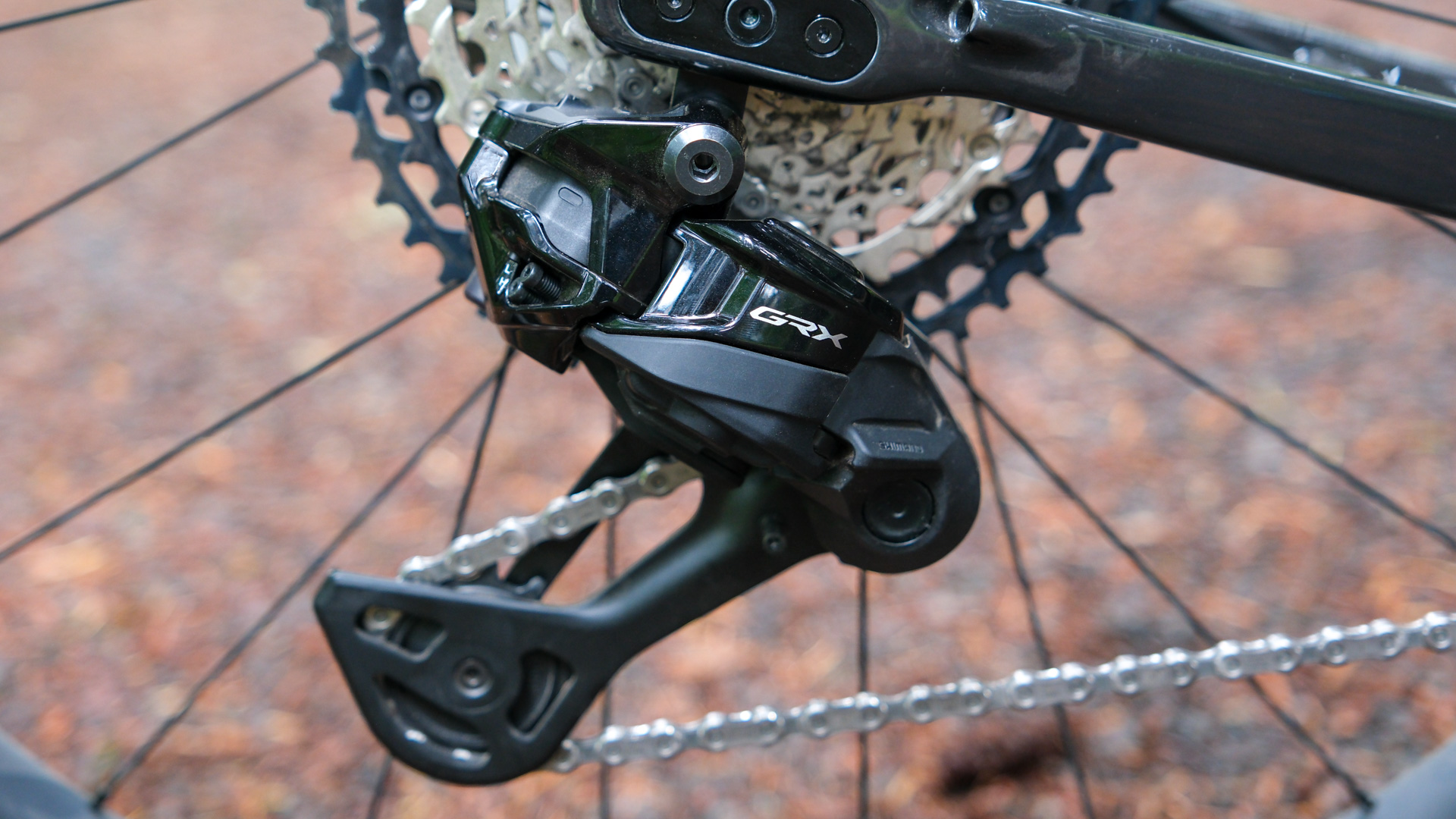
Better late than never. A full decade after SRAM launched its game-changing wireless eTap system, Shimano has finally arrived at the party. Today, the Japanese giant officially enters the fully wireless drop-bar category with a 1x12 GRX Di2 drivetrain sans junction boxes, seatpost batteries or external wires of any kind.
The centrepiece of Shimano’s wireless debut is the GRX RX827 rear derailleur, which houses its own battery and takes shifting cues from any of Shimano’s existing wireless Di2 shifters. And while SRAM and Campagnolo got there first, Shimano is betting the wait was worth it.
“We’re happy to have it now,” said Nick Legan, Shimano’s Gravel/Road Brand Manager. “I don’t think there’s anything wrong with being second [to market], but better.”
The RX827 rear derailleur works in tandem with the previously launched GRX RX820 and GRX 825 components to form a complete electronic groupset. And with this launch, Shimano’s 12-speed GRX ecosystem is now complete. And while the many part numbers and component names can seem confusing, the system is actually quite modular, letting riders mix and match parts across 1x and 2x setups to suit their riding riding style, terrain and budget.
What’s new
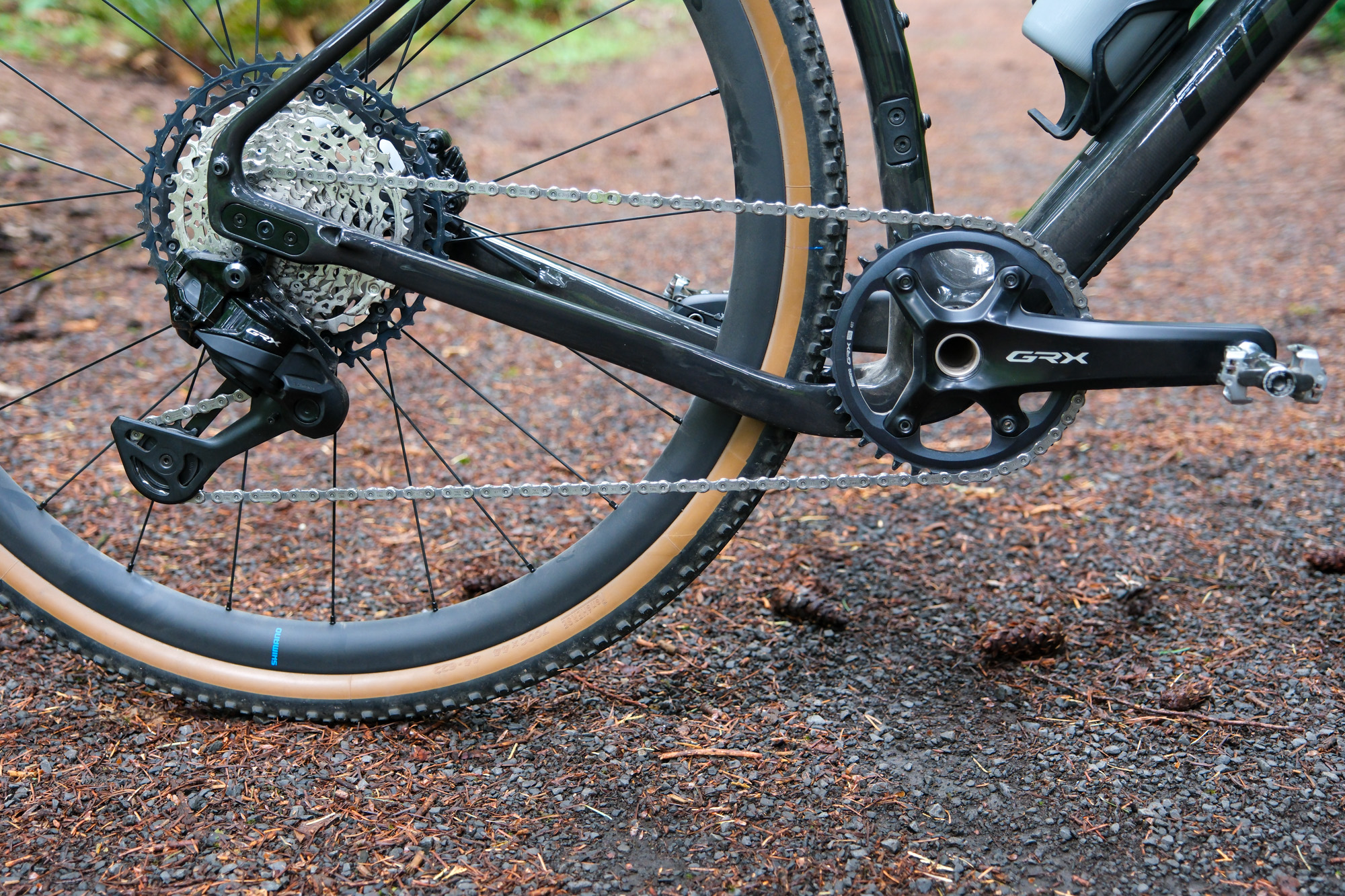
NEW - RX827 Rear Derailleur
At the heart of Shimano’s wireless debut is the battery-containing GRX RX827 rear derailleur, which is, in fact, nearly identical to the XT8250 mountain bike derailleur released three weeks ago.
The only real difference is the branding and finish. This rebranding is done simply so that Shimano can offer OEM brands a cohesive, gravel-specific drivetrain package while also avoiding potential confusion for consumers.
The key features of the new rear mech:
No more wires:
The RX827 derailleur houses a 305mAh battery in the center of the derailleur body, tucked behind a protective cover. The battery (part number BT-DN320) weighed in at 23g on my scale, has a claimed range of 750-1000km (466 - 621 miles) and can be charged fully in 90 minutes.
One quirk worth noting is that the derailleur doesn’t ship with the battery included. So if you’re buying it aftermarket, make sure to pick one up separately—and consider grabbing a spare while you’re at it.
It still uses a derailleur hanger:
While SRAM has gone all in on their hanger-free, UDH design, Shimano doubled down on the good ol’ derailleur hanger, citing broader frame compatibility and performance.
The GRX components blend technology from both Shimano’s road and mountain bike lines, but when it comes to impact resistance and durability, the design draws directly from lessons learned in the toughest mountain bike conditions.
"After studying lots of derailleurs that had failed after real impact on the trail, our engineers came up with a list of every kind of impact and the specific mode of failure it caused,” said Shimano North America’s MTB Product Manager, Nick Murdick. And the derailleur hanger remains “simply the best way to handle two key kinds of impact.”
Murdick explained that when the derailleur is hit from the side, “the derailleur is free to rotate around the axle where the derailleur mounts so that it can spring back on its own. With a hanger, the derailleur can take repeated impacts without the rider having to notice and reset it each time.”
For impacts from below, where the derailleur can’t rotate out of harm’s way, the hanger acts as a sacrificial part, bending or breaking to protect both the derailleur and frame.

No more clutch or lever:
Survivability was a key design focus for the RX827 derailleur, and Shimano has made some meaningful changes aimed at long-term durability and consistent performance on rough terrain and in muddy, Unbound-like conditions.
Previous GRX models used a lever-actuated clutch to manage chain tension and reduce chain slap. The RX827 foregoes a clutch system in favour of a dual spring design, designed to provide even stronger chain stabilisation and better chain wrap and retention. Shimano says this setup also won’t degrade over time and doesn’t require any maintenance. Plus, without a clutch lever, there’s also less piece of hardware exposed to potential harm.
Snag-free design was the name of the game for this new derailleur, which features Shimano’s new Shadow ES technology. The ES stands for “evolved and slim”, apparent in the rear mech’s smaller front-facing surface area and rounded skid plate design.
Automatic Impact Recovery Function:
Should you still manage to snag the derailleur on a rock, the derailleur features a motor unit that will automatically reset the derailleur to its position. No manual adjustments required.
Cross-category compatibility:
Modularity being at the center of Shimano GRX line, users will be glad to hear that the new derailleur can be used with any Shimano 12-speed wireless shifters. GRX, Dura-Ace, Ultegra, 105, XTR, DEORE XT – if it’s electronic, 12-speed and wireless, it’ll work.
Long cage only:
While its XT sibling offer two cage sizes, the GRX model only comes in the large cage model, compatible with a 10-51t cassette.
NEW - BL RX827 Brake shift lever

While the wireless system will play nice with any wireless Di2 shifters, Shimano did use this launch to introduce a 1x-specific left lever. The new BL-RX825-L brake lever is a brake-only lever designed specifically for 1x12-speed setups. The lever uses the same ergonomics, ribbed surfaces and anti-slip coating as the RX825 dual control levers (from the previous 2x12 GRX Di2 launch) but it does not have any buttons whatsoever. It was made for those looking for a slightly lighter, simple and cost-saving alternative.
For the right lever, and for those wanting all the buttons, the groupset carries over the very comfortable RX825 dual control levers with its three-button configuration: two on the paddles and one bonus button on the inside of the hoods. Each button can be assigned various functions, including shifting , scrolling through the pages of your cycling computer, or controlling compatible lights.
New - M8200 XT Cassette
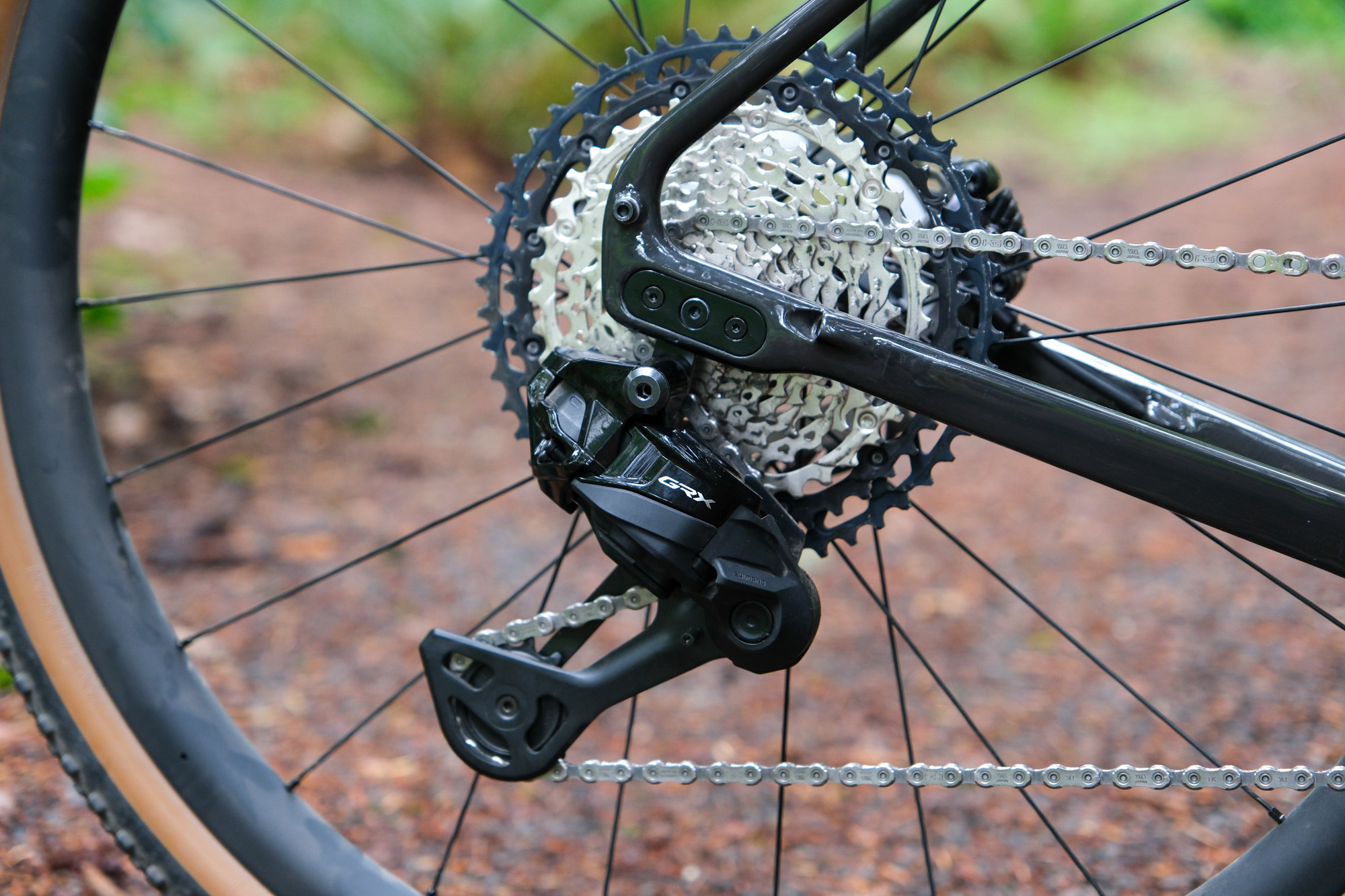
Also borrowed from the mountain bike side is the new M8200 XT cassette. The M8200 is approximately 40 grams lighter than its predecessor, the M8100, and features a slightly updated tooth profile, which adds more material at the base of certain teeth for improved durability. It’s also got an updated rivet structure designed to reduce or prevent creaking.
With that said, the rear derailleur is compatible with any existing 12-speed 10-51t cassette.
Make it yours
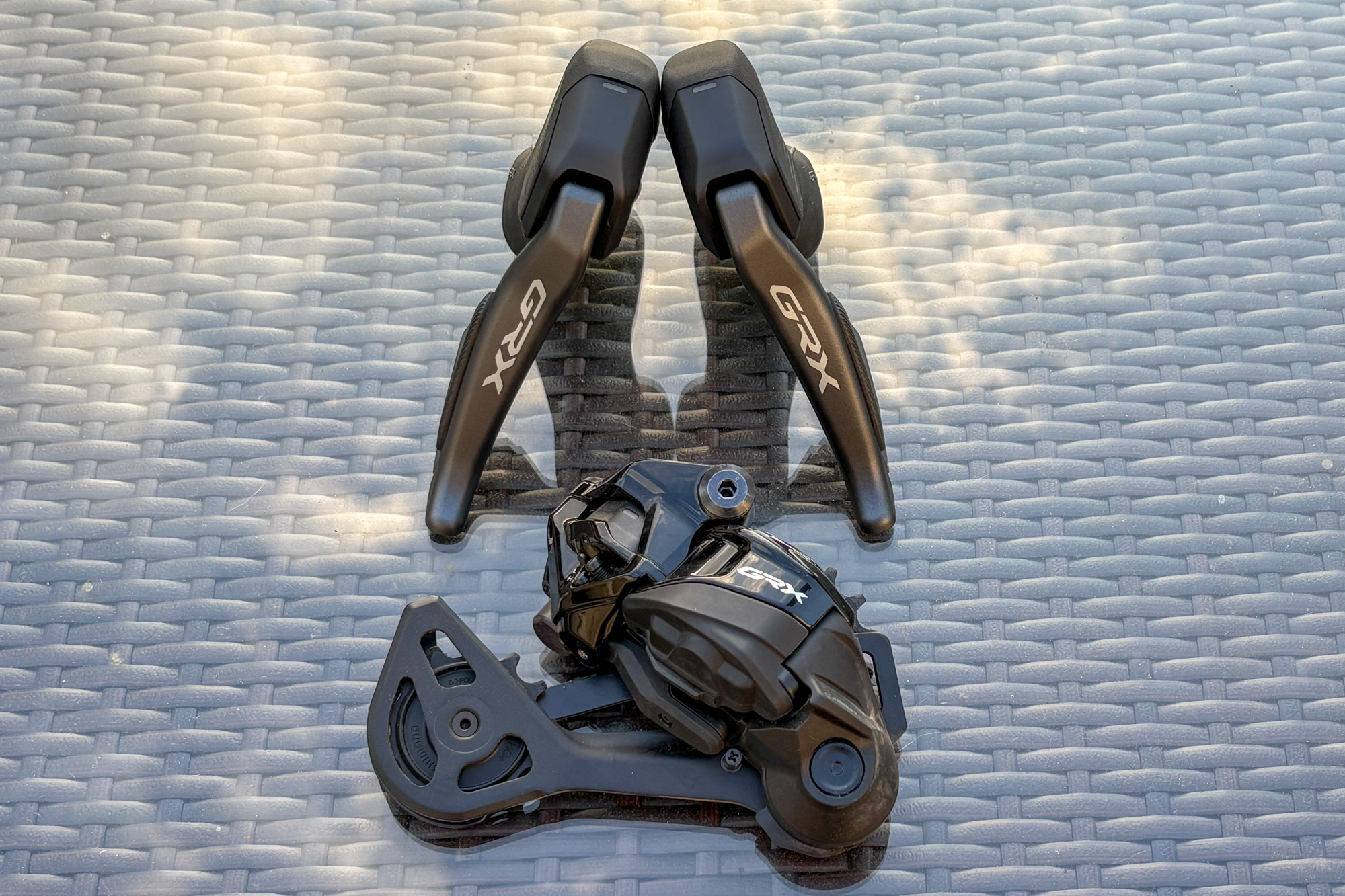
There are only three new components here, and only one of them is essential for building a fully wireless Shimano drop-bar setup: the rear derailleur. The rest can be mixed and matched from existing parts, which gives the aftermarket plenty of flexibility and customisation options. You’ll just need a Shimano 12-speed-compatible chain, 1x crankset, a 10-51T cassette, and Di2 shifters to complete the build.
When spec’d on a new bike, most of the groupset will consist of carryover parts. For example::
- RD-RX827 rear derailleur + BT-DN320 battery
- RX825 dual control levers OR a BL-RX825 left lever and a RX825 dual control right lever
- Shimano GRX FC-RX820 1x 12-Speed Crankset with either a 40 or 42t chainring
- CS-M8200 (10-51) cassette
- CN-M8100 12-speed chain
- BT-DN320 battery
- BR-RX820 crankset with either a 40t or 42t chainring
One thing to note is that GRX cranks are limited to 170mm crank arm length so if you’re looking for 165mm cranks like Tadej, you’ll have to use road cranks.
Prices & Weights
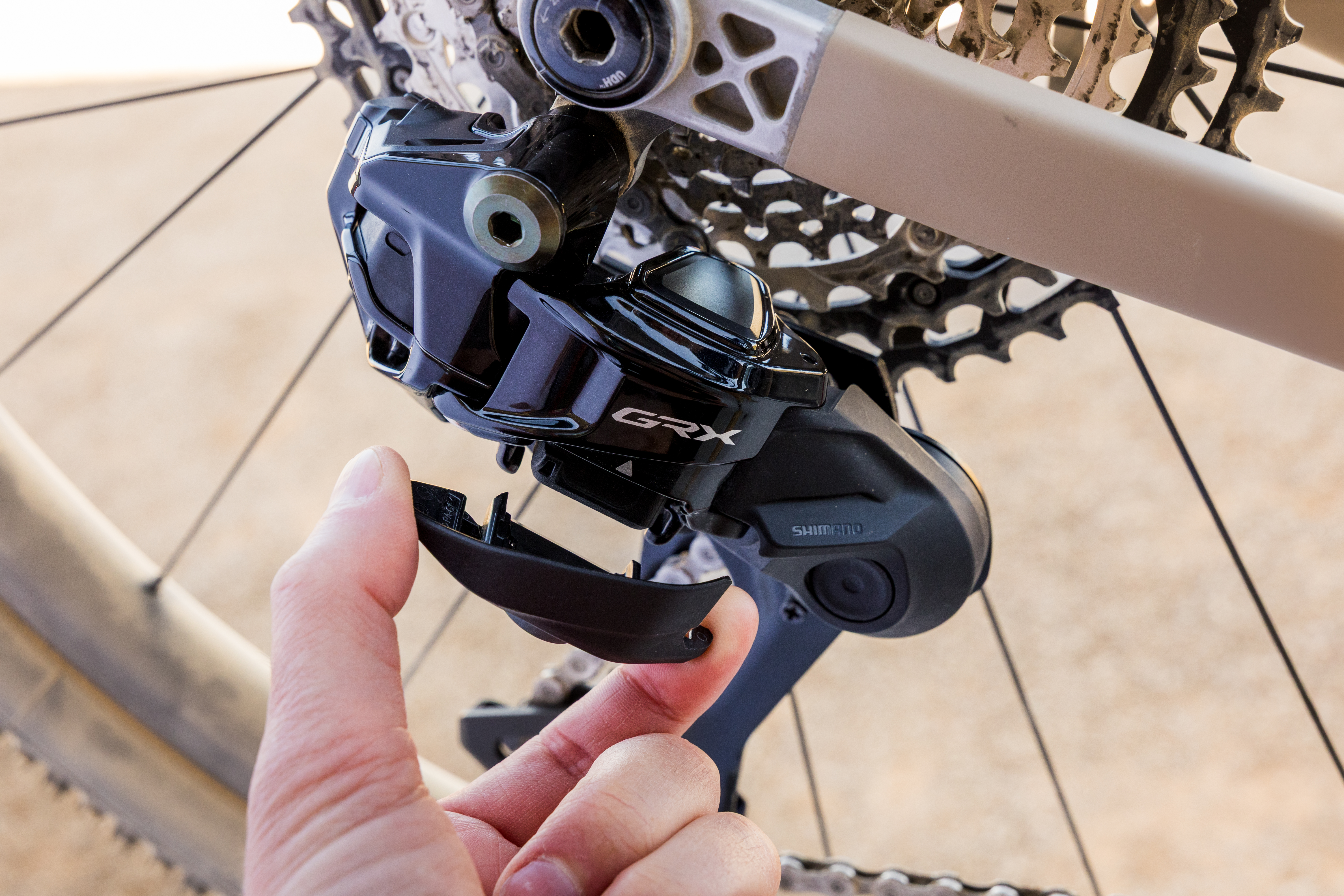
Part |
Claimed weight |
USD |
£ |
GRX crankset (RX820-1 ) w/ 40t chainring, 170mm crank arms |
644g |
$280 |
£229.99 |
Rear derailleur (GRX RX827) |
454g |
$565 |
£429.99 |
Derailleur battery (BT-DN320 ) |
26.5g |
$55 |
£39.99 |
Left brake-only lever (BL-RX825 ) + BR-RX820 caliper |
395g |
$345 |
£299.99 |
Right brake-shift lever (ST RX825)+ BR RX820 caliper |
415g |
$595 |
£339.00 |
Cassette (CS-M8200) - 10-50t |
463g |
$195 |
£149.99 |
Battery charger |
- |
$45 |
£29.99 |
Brake rotor (CL800) - 160mm w/ lockring |
169g |
$70 |
£34.99 |
Chain (M8100) |
252g |
$65 |
£49.99 |
The long road to wireless
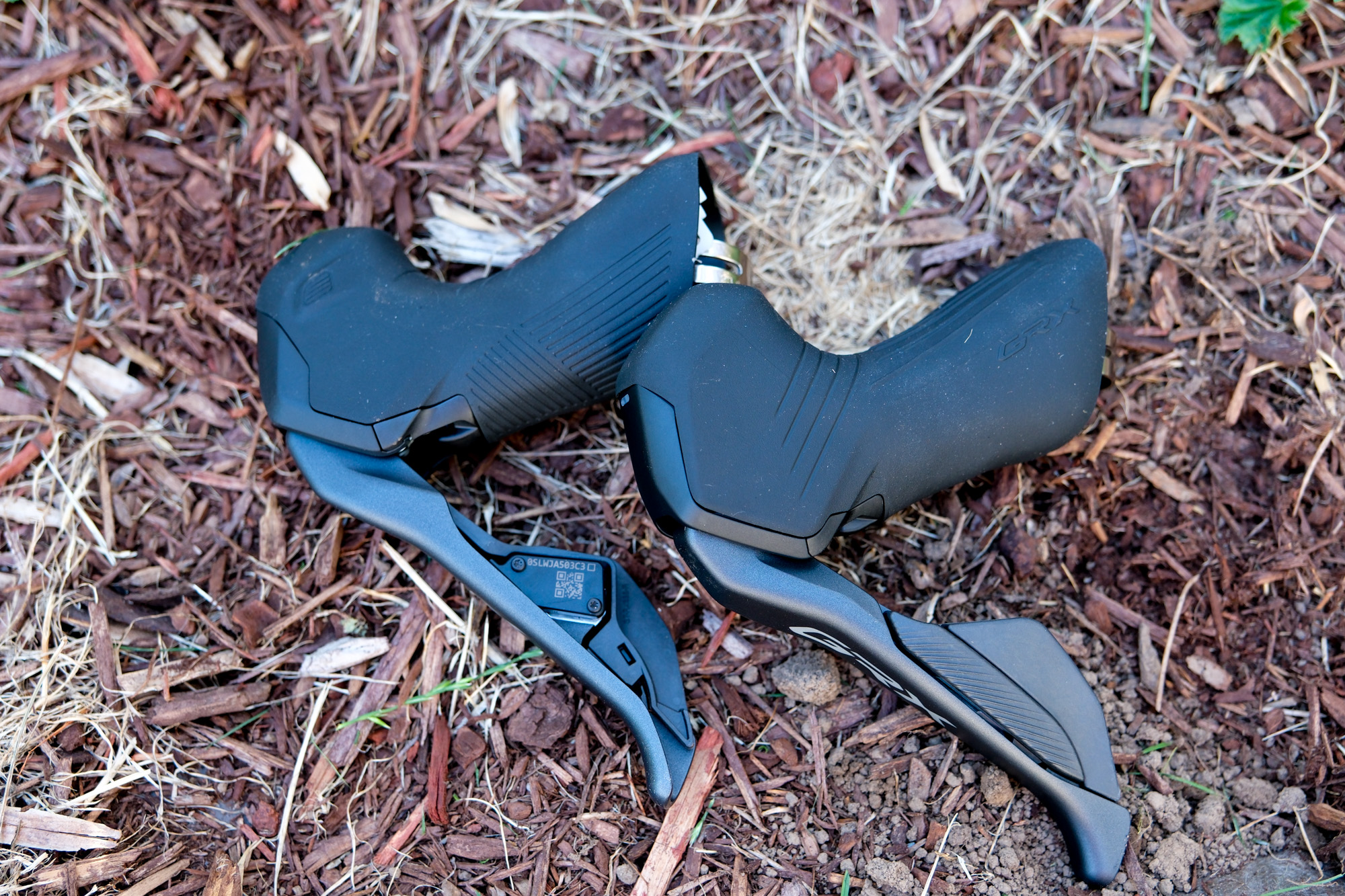
Shimano may be late in introducing its first truly wireless system but it's no stranger to electronic shifting. It even helped pioneer the category with the launch of Dura-Ace Di2 more than 15 years ago.
While SRAM and Campagnolo moved more quickly to eliminate wires entirely (and add gears), Shimano has taken a more measured approach, refining its systems over time and prioritising reliability, compatibility and the breadth of its product ecosystem.
“We speak to and serve a much broader range of people than any component makers on the market,” Legan said, emphasising that innovation doesn’t always mean being first; it can mean being thoughtful, versatile and inclusive.
Here's a quick look at the key electronic milestones that led to this long-awaited moment.
2009 – Shimano launches its first electronic groupset, Dura‑Ace Di2 (7970). It was fully wired with junction boxes and an externally mounted battery.
2011 – Ultegra Di2 (6770) brings Di2 technology to a wider market.
2014 – Shimano introduces its first electronic mtb groupset, XTR Di2 (M9050). Still fully wired but it featured customisable shifting via E-Tube software.
2017 – Dura‑Ace R9150 Di2 adds Bluetooth/ANT+ connectivity to Garmin, E-Tube app, etc.
2021 – Dura‑Ace R9200 and Ultegra R8100 offer a 12-speed drivetrain without junction boxes. In the semi-wireless system, the shifters are (coin cell) battery powered but the derailleurs are still wired to a seatpost-integrated battery.
2022 – Shimano brings semi-wireless Di2 to its more affordable 105 R7100 groupset.
2025 – Shimano introduces M9250 XTR Di2, M8250 Deore XT and GRX RX827, its first fully wireless shifting systems for dropbar and MTB. Shifters powered by coin cell batteries, derailleur powered by a rechargeable battery.
What the pros will be riding

I asked several Shimano-sponsored gravel athletes about their preferred setup, and many said they’ll likely stick with the existing 2x GRX Di2 system. For long races like the 200-mile Unbound, they value the smoother gear steps and greater pedaling efficiency. That said, they see the new 1x system being useful in muddy conditions or when running extra-wide tyres—situations where a front derailleur can become a limiting factor.
When opting for the 1x system, pros will likely assemble the lightest groupset possible, by borrowing from the road and mountain bike collection where it makes sense. An example of a pro build, as shared by gravel rider Pete Stetina, would be:
- XTR M9250 rear derailleur (because it’s lighter than the GRX version)
- 10-51t M8200 cassette
- GRX RX825 Shifters
- Dura Ace cranks with a custom aero chainring (again, lighter than what GRX offers)
Is the future wire-free?

When I asked whether we could expect Shimano’s future road groupsets to go fully wireless too, the company was tight-lipped. “Don’t ever assume anything,” was the response I got. So, in other words, Shimano’s not ready to tip its hand just yet.
First Ride Review
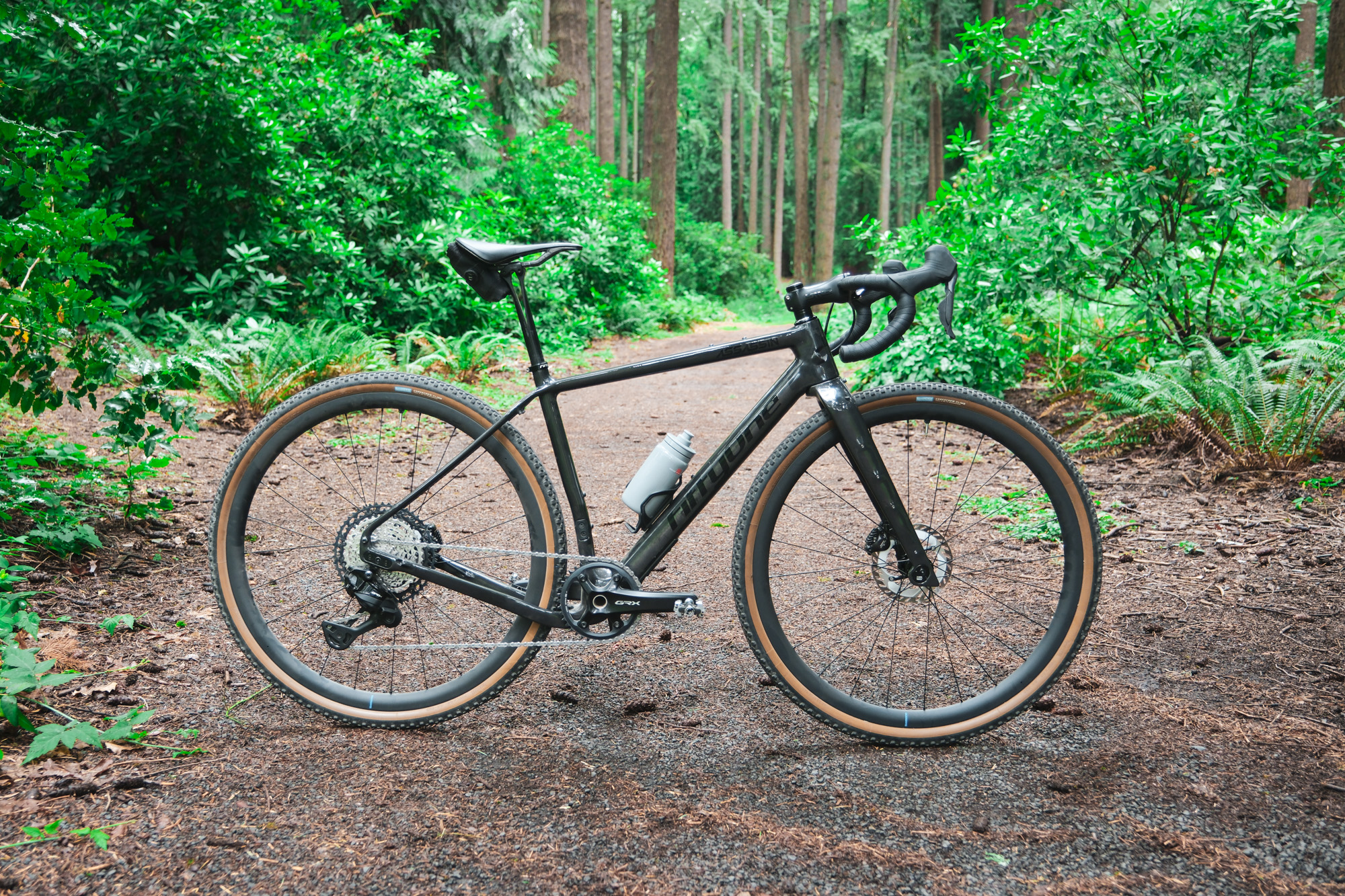
By now, I’ve ridden almost all of Shimano’s 12-speed gravel product line. The 2023-released 12-speed mechanical groupset reminded me how good a mechanical system can be while last year’s 2x12 GRX Di2 groupset had me appreciate the benefits of 2x shifting all over again.
Still, while I couldn’t fault either groupset, I couldn’t help but wonder if Shimano is doing enough to be competitive in the gravel space. For some time now, Shimano has been reacting to the market—playing catch-up on things like gear range and wireless tech—rather than leading it. Then again, that might reflect the simple reality that gravel, while growing fast, is only a tiny slice of Shimano’s business. The company’s dominance in road, OEM spec, and global market share is unmatched.
This newest addition could mark a step forward for the brand, but is it enough? And was it worth the wait? What can this do better that SRAM’s XPLR and mountain bike lines?
I haven’t gotten to ride a ton of miles on the wireless system yet, so stay tuned for my long-term review but here are my initial takeaways.

Three positives:
It’s wireless. According to Shimano, the vast majority of the market wants mechanical, not electronic. Wires offer a sense of security as having to charge a battery frequently stresses folks out. I can see the logic behind that reasoning but personally, I am a big fan of wireless groupsets and have been using them for a long time for three key reasons: ease of installation, being able to easily remove the rear mech for travel and the freedom to use any seatpost I want.
To prevent running out of battery and being left with a single speed –which has happened only three times in nearly a decade of using eTap/AXS– I simply carry a spare battery in my bar bag.
The claimed range on a single battery is enough for even most bikepacking trips. And again, the battery is easy to swap and light enough to carry a spare or two on long trips.
Holy shiftspeed, Batman!
Shifting up and down the cassette is wildly fast. Hands down the faster of any electronic drivetrain I have used to date. So fast, in fact, that you can opt to slow it down in the e-tube app (to reduce drivetrain stress and avoid accidental multi shifts). You don’t even need to press the button multiple times, you can simply push the button, hold it, and watch as the chain slides down or climbs up the cassette (while pedaling of course).
It’s certainly faster, crisper and more reliable than its mechanical sibling. On the latter, the system appeared a bit sensitive on the bigger jumps of the upper end of the cassette, and required frequent adjustments.
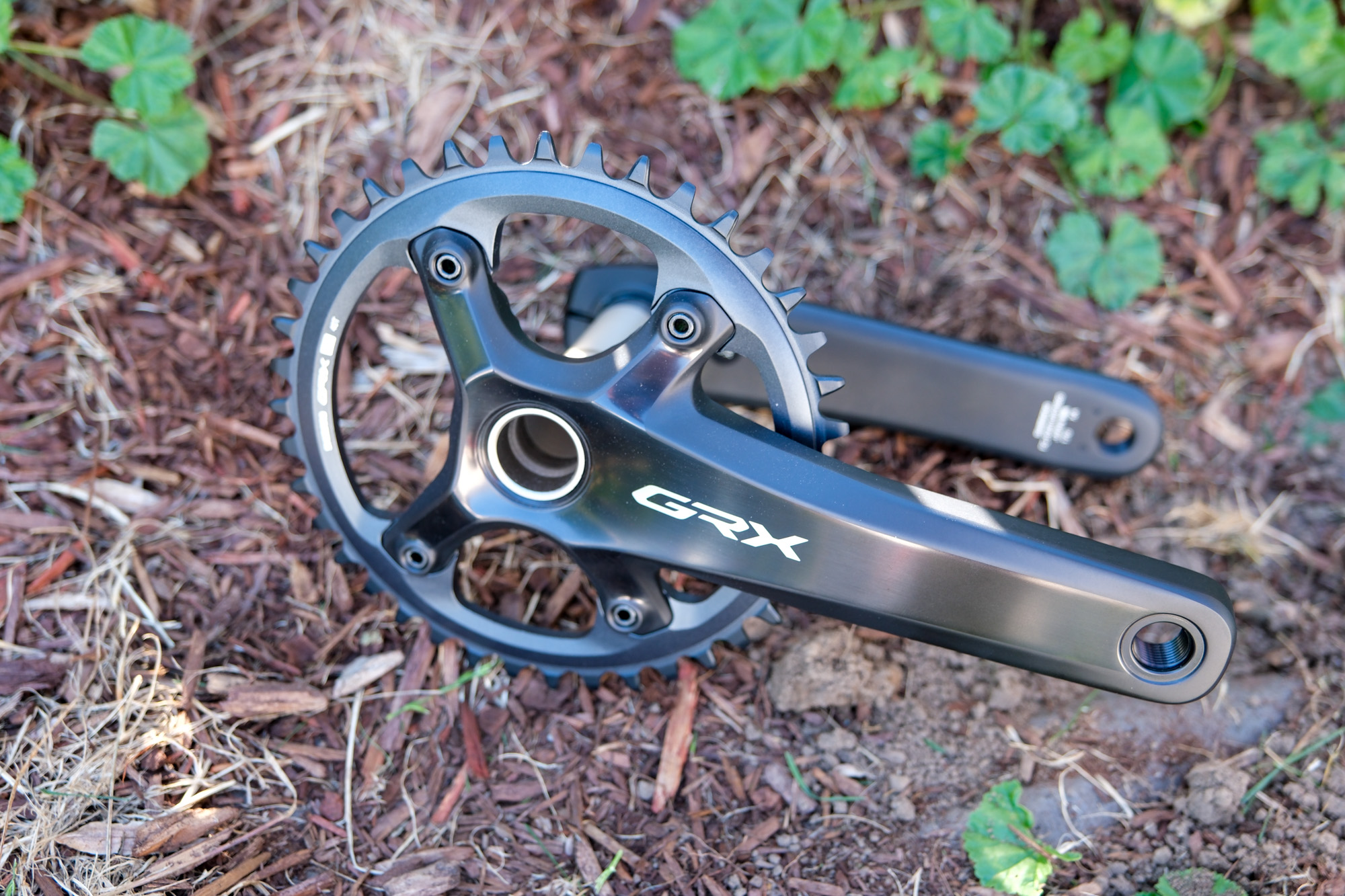
Modularity and configurability
One of my favourite things about how Shimano approached its GRX product line is the modularity. There are a few set pieces — the crankset, the brake calipers — that appear in all the 12-speed GRX groupsets and from there it's a plug-and-play system. The cross-groupset compatibility gives riders flexibility when building or upgrading their setup. Whether you’re chasing grams for a race build or assembling a reliable, rugged bikepacking rig, the ecosystem allows you to assemble a groupset that matches your specific riding style, terrain and budget.
While the same can be said about SRAM's wireless components, Shimano appears to embrace a more unified approach. SRAM typically distinguishes its groupsets with clear tier markings. i.e RIVAL or FORCE displayed prominently on levers and derailleurs and distinct colourways. In contrast, Shimano opts for consistent branding across its GRX lineup, labeling levers and cranksets simply as "GRX" regardless of whether they're part of the 600, 820 or 825 series. Even among pro athletes, Shimano encourages the hodgepodge approach, blending Dura-Ace, GRX, and XTR components into one groupset.
I think this modularity is appealing to the aftermarket — particularly for tinkerers and setup-optimisers, which are especially common in the gravel sector.
And when it comes to customisations, the E-Tube app is a simple but powerful tool. The app lets you tweak shifting preferences like multi-shift behavior (one gear, two, or continuous), adjust shift speed, program the auxiliary buttons, and assign specific functions to different shifter buttons. Shimano sure has come a long way since the early days of Di2, when making changes meant physically plugging into a desktop.
Three downsides
1. Smoothness
The shifting is certainly fast and reliable but that buttery smooth feeling Shimano is known for? I think the 2x12 GRX Di2 and the Dura Ace Di2 road drivetrains still have an edge.
2. Microspline freehub compatibility
The 10-51T cassette uses a Microspline freehub body, which can be limiting when it comes to wheel and hub options. While it’s an improvement over the HG L2 freehub seen on the 820 series, Microspline is still far less common on gravel and road wheels, where HG and XDR dominate.
3. Availability
If this novel-length feature got you excited about the new rear derailleur, I must apologise and deliver some bad news: the GRX RX827 derailleur won’t be available until late August - early September.







